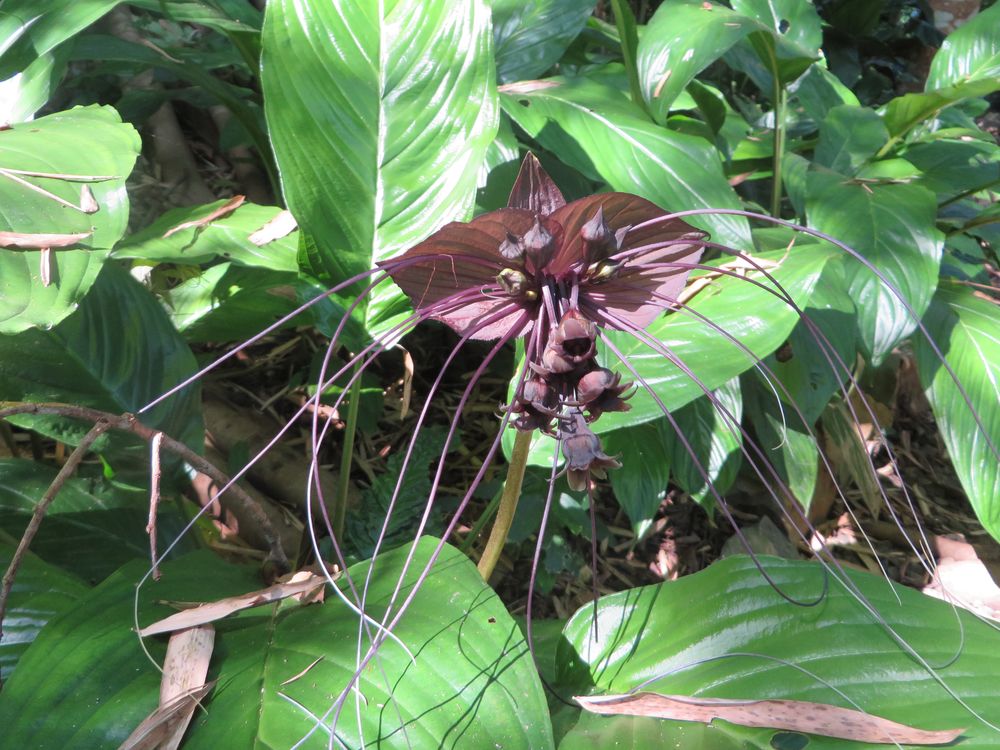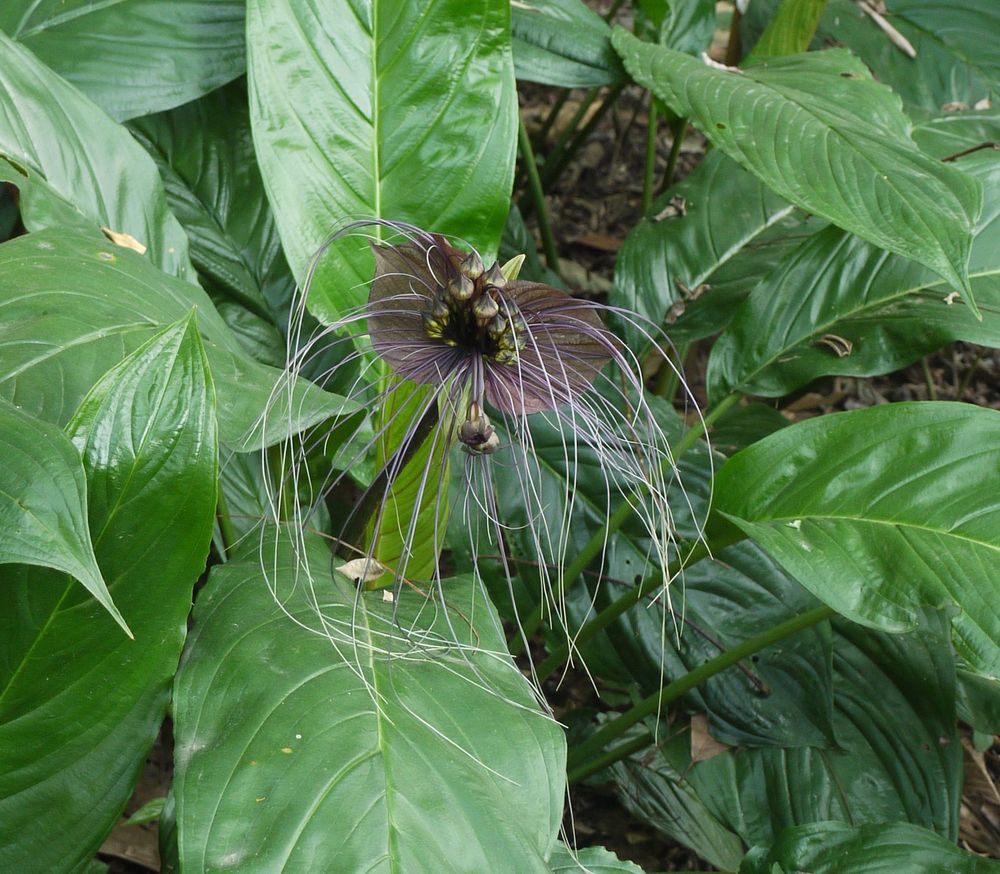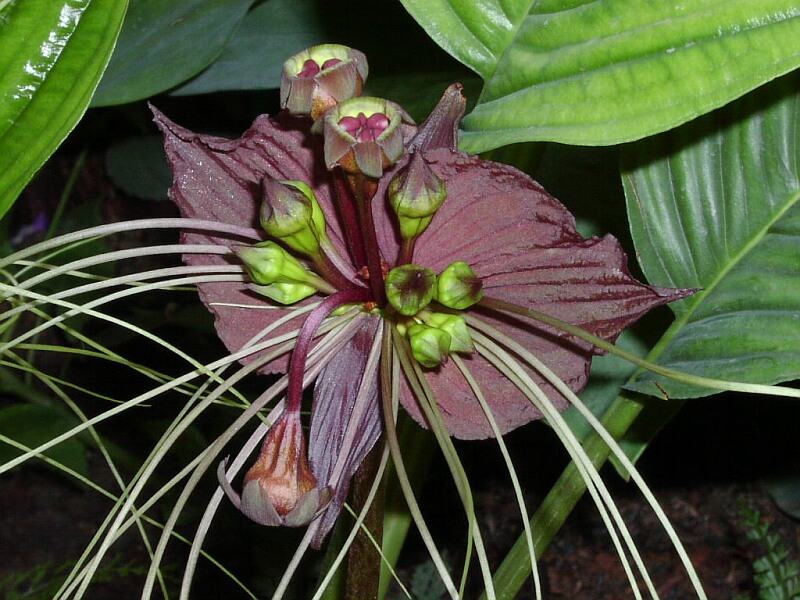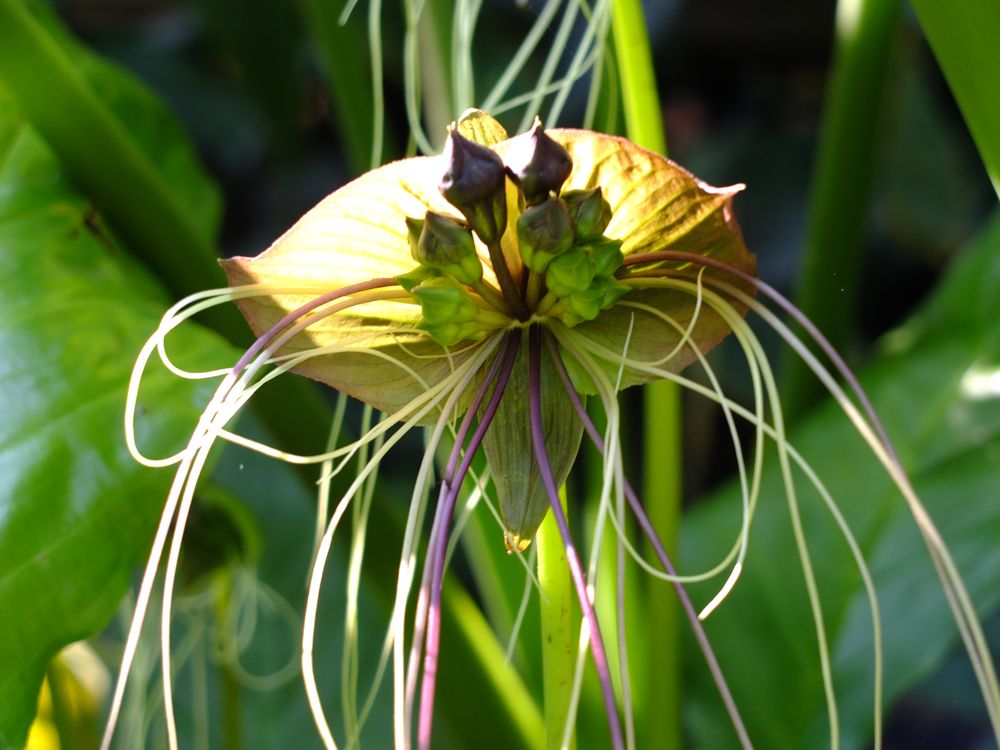Tiger’s moustache (Moustaches de tigre, the French name), Black bat flower – the names for this plant are very imaginative in multiple languages, no doubt due to their amazing beauty, mesmerizing colour and strange appearance.
The Tacca genus, which belongs to the Yam family, gets its name from the Indonesian word, taka, which is the Indonesian name for these plants. The two genera and thirteen species in this plant family come almost exclusively from Asia.
They look similar to the yams with which they are often confused, and they are perennials with tuberous roots. They have large, elongated, simple leaves, sometimes lobed, growing directly from the tuber. The flowers are grouped in umbels at the end of long stalks, also attached directly to the tuber. The most spectacular part of the plant is undoubtedly the large bracts extending like wings around the flowers. Next to these, there are long filaments (bracteoles) which give the inflorescence the appearance of feline whiskers. The actual flowers are clustered in the middle of all of this and are the most unassuming part of the whole thing!
Numerous species of Tacca can be found in Laos, the most spectacular of which, the Tacca chantrieri, is cultivated extensively as a decorative plant, but is also found growing wild in the humid areas of northern Laos and in Khammouane province. The black bat flower has been extensively exploited for horticultural use, with so many plants being collected from the wild that, in China, the plant is a protected species.
As beautiful as the flower is, one can also use the tuber as food or medication. The Hmong people consume this root after having macerated it for a long period to eliminate its bitterness. In Vietnam, in all seasons, the harvested rhizomes are washed, cut into fine strips, put in the sun to dry, or steamed, and then put to macerate in alcohol. This preparation is used in massage in the case of rheumatic fever.
Prone men, « Pork-epic paunch» is the name the Lao give to Tacca chantrieri but also to the similar species Tacca integrifolia. This flower, equally as complex as that of the black bat flower, is, however, less spectacular because its « wings » are smaller and a greenish or white colour.
In the north, the young leaves of both species are grilled or eaten raw with an accompanying piquant sauce. They have a pleasant bitterness and are strengthened when consumed.
In the past, the tubers, rich in starch, were fermented to make alcohol. Today, the Traditional Medicine Research Center has registered this plant for its phytotherapy properties. In Akha villages, the decoction of the rhizome is prescribed as an aphrodisiac and in cases of anaemia.
Moustache de tigre, Chauve-souris noire, Panse de porc-épic, les langues rivalisent d’imagination pour nommer ces plantes à la beauté sulfureuse, envoûtantes par leur couleur et par leur forme étrange.
Le genre Tacca qui appartient à la famille des Dioscoréacées tient son nom du mot indonésien « taka » qui désigne localement ces plantes. En effet, les deux genres et treize espèces de cette famille se rencontrent presque exclusivement en Asie. Proche des ignames avec lesquelles elles ont parfois été confondues, ce sont des plantes vivaces à tubercules. Elles ont de grandes feuilles oblongues, simples, parfois lobées, partant directement de la racine. Les fleurs sont groupées en ombelle au bout de longues tiges elles aussi fixées sur le tubercule; mais la partie spectaculaire de la plante consiste en grandes bractées ou feuilles se déployant comme des ailes au-dessus des fleurs; en outre de très longs filaments (bractéoles) s’échappent des inflorescences comme des moustaches de félin.
Au Laos, on trouve plusieurs Tacca dont le plus spectaculaire, Tacca chantrieri, est aujourd’hui cultivé comme plante décorative mais se rencontre aussi à l’état sauvage dans les endroits humides du Nord et jusqu’à la province de Khamouane. Moustache de tigre en français, Devil Flower ou Bat Flower en anglais, tels sont les noms donnés à cette fleur entièrement noir violacé, largement exploitée par les horticulteurs au point que la plante est, en Chine, une espèce protégée. Si l’on admire la fleur on peut aussi utiliser le tubercule comme nourriture ou médicament ; c’est ce que font les Hmong qui consomment cette racine après l’avoir fait macérer longuement pour en éliminer le principe amer. Au Vietnam, les rhizomes récoltés en toutes saisons sont lavés, coupés en tranches fines, séchés au soleil ou à l’étuve et mis à macérer dans de l’alcool ; cette préparation est utilisée en massage pour soigner les rhumatismes articulaires.
Prone men, « panse de porc-épic » est le nom que les Lao donnent à Tacca integrifolia; La fleur tout aussi complexe que la précédente est cependant moins spectaculaire car ses « ailes » sont plus discrètes et de couleur verdâtre ou blanche.
Dans le Nord on mange les jeunes feuilles grillées ou crues avec une sauce piquante, elles sont d’une agréable amertume et donnent de la force.
Le tubercule riche en amidon était utilisé autrefois comme ferment pour fabriquer l’alcool de riz. Aujourd’hui l’IMT a inscrit cette plante dans sa phytothérapie. Chez les Akha la décoction du rhizome est prescrite, comme aphrodisiaque et en cas d’anémie.




Tiger’s moustache (Moustaches de tigre, the French name), Black bat flower – the names for this plant are very imaginative in multiple languages, no doubt due to their amazing beauty, mesmerizing colour and strange appearance.
The Tacca genus, which belongs to the Yam family, gets its name from the Indonesian word, taka, which is the Indonesian name for these plants. The two genera and thirteen species in this plant family come almost exclusively from Asia.
They look similar to the yams with which they are often confused, and they are perennials with tuberous roots. They have large, elongated, simple leaves, sometimes lobed, growing directly from the tuber. The flowers are grouped in umbels at the end of long stalks, also attached directly to the tuber. The most spectacular part of the plant is undoubtedly the large bracts extending like wings around the flowers. Next to these, there are long filaments (bracteoles) which give the inflorescence the appearance of feline whiskers. The actual flowers are clustered in the middle of all of this and are the most unassuming part of the whole thing!
Numerous species of Tacca can be found in Laos, the most spectacular of which, the Tacca chantrieri, is cultivated extensively as a decorative plant, but is also found growing wild in the humid areas of northern Laos and in Khammouane province. The black bat flower has been extensively exploited for horticultural use, with so many plants being collected from the wild that, in China, the plant is a protected species.
As beautiful as the flower is, one can also use the tuber as food or medication. The Hmong people consume this root after having macerated it for a long period to eliminate its bitterness. In Vietnam, in all seasons, the harvested rhizomes are washed, cut into fine strips, put in the sun to dry, or steamed, and then put to macerate in alcohol. This preparation is used in massage in the case of rheumatic fever.
Prone men, « Pork-epic paunch» is the name the Lao give to Tacca chantrieri but also to the similar species Tacca integrifolia. This flower, equally as complex as that of the black bat flower, is, however, less spectacular because its « wings » are smaller and a greenish or white colour.
In the north, the young leaves of both species are grilled or eaten raw with an accompanying piquant sauce. They have a pleasant bitterness and are strengthened when consumed.
In the past, the tubers, rich in starch, were fermented to make alcohol. Today, the Traditional Medicine Research Center has registered this plant for its phytotherapy properties. In Akha villages, the decoction of the rhizome is prescribed as an aphrodisiac and in cases of anaemia.
Moustache de tigre, Chauve-souris noire, Panse de porc-épic, les langues rivalisent d’imagination pour nommer ces plantes à la beauté sulfureuse, envoûtantes par leur couleur et par leur forme étrange.
Le genre Tacca qui appartient à la famille des Dioscoréacées tient son nom du mot indonésien « taka » qui désigne localement ces plantes. En effet, les deux genres et treize espèces de cette famille se rencontrent presque exclusivement en Asie. Proche des ignames avec lesquelles elles ont parfois été confondues, ce sont des plantes vivaces à tubercules. Elles ont de grandes feuilles oblongues, simples, parfois lobées, partant directement de la racine. Les fleurs sont groupées en ombelle au bout de longues tiges elles aussi fixées sur le tubercule; mais la partie spectaculaire de la plante consiste en grandes bractées ou feuilles se déployant comme des ailes au-dessus des fleurs; en outre de très longs filaments (bractéoles) s’échappent des inflorescences comme des moustaches de félin.
Au Laos, on trouve plusieurs Tacca dont le plus spectaculaire, Tacca chantrieri, est aujourd’hui cultivé comme plante décorative mais se rencontre aussi à l’état sauvage dans les endroits humides du Nord et jusqu’à la province de Khamouane. Moustache de tigre en français, Devil Flower ou Bat Flower en anglais, tels sont les noms donnés à cette fleur entièrement noir violacé, largement exploitée par les horticulteurs au point que la plante est, en Chine, une espèce protégée. Si l’on admire la fleur on peut aussi utiliser le tubercule comme nourriture ou médicament ; c’est ce que font les Hmong qui consomment cette racine après l’avoir fait macérer longuement pour en éliminer le principe amer. Au Vietnam, les rhizomes récoltés en toutes saisons sont lavés, coupés en tranches fines, séchés au soleil ou à l’étuve et mis à macérer dans de l’alcool ; cette préparation est utilisée en massage pour soigner les rhumatismes articulaires.
Prone men, « panse de porc-épic » est le nom que les Lao donnent à Tacca integrifolia; La fleur tout aussi complexe que la précédente est cependant moins spectaculaire car ses « ailes » sont plus discrètes et de couleur verdâtre ou blanche.
Dans le Nord on mange les jeunes feuilles grillées ou crues avec une sauce piquante, elles sont d’une agréable amertume et donnent de la force.
Le tubercule riche en amidon était utilisé autrefois comme ferment pour fabriquer l’alcool de riz. Aujourd’hui l’IMT a inscrit cette plante dans sa phytothérapie. Chez les Akha la décoction du rhizome est prescrite, comme aphrodisiaque et en cas d’anémie.








Tiger’s moustache (Moustaches de tigre, the French name), Black bat flower – the names for this plant are very imaginative in multiple languages, no doubt due to their amazing beauty, mesmerizing colour and strange appearance.
The Tacca genus, which belongs to the Yam family, gets its name from the Indonesian word, taka, which is the Indonesian name for these plants. The two genera and thirteen species in this plant family come almost exclusively from Asia.
They look similar to the yams with which they are often confused, and they are perennials with tuberous roots. They have large, elongated, simple leaves, sometimes lobed, growing directly from the tuber. The flowers are grouped in umbels at the end of long stalks, also attached directly to the tuber. The most spectacular part of the plant is undoubtedly the large bracts extending like wings around the flowers. Next to these, there are long filaments (bracteoles) which give the inflorescence the appearance of feline whiskers. The actual flowers are clustered in the middle of all of this and are the most unassuming part of the whole thing!
Numerous species of Tacca can be found in Laos, the most spectacular of which, the Tacca chantrieri, is cultivated extensively as a decorative plant, but is also found growing wild in the humid areas of northern Laos and in Khammouane province. The black bat flower has been extensively exploited for horticultural use, with so many plants being collected from the wild that, in China, the plant is a protected species.
As beautiful as the flower is, one can also use the tuber as food or medication. The Hmong people consume this root after having macerated it for a long period to eliminate its bitterness. In Vietnam, in all seasons, the harvested rhizomes are washed, cut into fine strips, put in the sun to dry, or steamed, and then put to macerate in alcohol. This preparation is used in massage in the case of rheumatic fever.
Prone men, « Pork-epic paunch» is the name the Lao give to Tacca chantrieri but also to the similar species Tacca integrifolia. This flower, equally as complex as that of the black bat flower, is, however, less spectacular because its « wings » are smaller and a greenish or white colour.
In the north, the young leaves of both species are grilled or eaten raw with an accompanying piquant sauce. They have a pleasant bitterness and are strengthened when consumed.
In the past, the tubers, rich in starch, were fermented to make alcohol. Today, the Traditional Medicine Research Center has registered this plant for its phytotherapy properties. In Akha villages, the decoction of the rhizome is prescribed as an aphrodisiac and in cases of anaemia.
Moustache de tigre, Chauve-souris noire, Panse de porc-épic, les langues rivalisent d’imagination pour nommer ces plantes à la beauté sulfureuse, envoûtantes par leur couleur et par leur forme étrange.
Le genre Tacca qui appartient à la famille des Dioscoréacées tient son nom du mot indonésien « taka » qui désigne localement ces plantes. En effet, les deux genres et treize espèces de cette famille se rencontrent presque exclusivement en Asie. Proche des ignames avec lesquelles elles ont parfois été confondues, ce sont des plantes vivaces à tubercules. Elles ont de grandes feuilles oblongues, simples, parfois lobées, partant directement de la racine. Les fleurs sont groupées en ombelle au bout de longues tiges elles aussi fixées sur le tubercule; mais la partie spectaculaire de la plante consiste en grandes bractées ou feuilles se déployant comme des ailes au-dessus des fleurs; en outre de très longs filaments (bractéoles) s’échappent des inflorescences comme des moustaches de félin.
Au Laos, on trouve plusieurs Tacca dont le plus spectaculaire, Tacca chantrieri, est aujourd’hui cultivé comme plante décorative mais se rencontre aussi à l’état sauvage dans les endroits humides du Nord et jusqu’à la province de Khamouane. Moustache de tigre en français, Devil Flower ou Bat Flower en anglais, tels sont les noms donnés à cette fleur entièrement noir violacé, largement exploitée par les horticulteurs au point que la plante est, en Chine, une espèce protégée. Si l’on admire la fleur on peut aussi utiliser le tubercule comme nourriture ou médicament ; c’est ce que font les Hmong qui consomment cette racine après l’avoir fait macérer longuement pour en éliminer le principe amer. Au Vietnam, les rhizomes récoltés en toutes saisons sont lavés, coupés en tranches fines, séchés au soleil ou à l’étuve et mis à macérer dans de l’alcool ; cette préparation est utilisée en massage pour soigner les rhumatismes articulaires.
Prone men, « panse de porc-épic » est le nom que les Lao donnent à Tacca integrifolia; La fleur tout aussi complexe que la précédente est cependant moins spectaculaire car ses « ailes » sont plus discrètes et de couleur verdâtre ou blanche.
Dans le Nord on mange les jeunes feuilles grillées ou crues avec une sauce piquante, elles sont d’une agréable amertume et donnent de la force.
Le tubercule riche en amidon était utilisé autrefois comme ferment pour fabriquer l’alcool de riz. Aujourd’hui l’IMT a inscrit cette plante dans sa phytothérapie. Chez les Akha la décoction du rhizome est prescrite, comme aphrodisiaque et en cas d’anémie.


